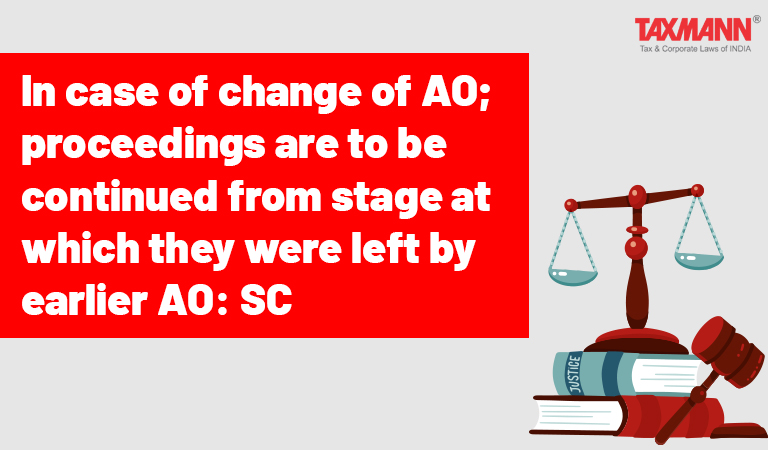In case of change of AO; proceedings are to be continued from stage at which they were left by earlier AO: SC
- News|Blog|Income Tax|
- 2 Min Read
- By Taxmann
- |
- Last Updated on 26 November, 2022

Case Details: DCIT Vs. Mastech Technologies (P.) Ltd. - [2022] 145 taxmann.com 157 (SC)
Judiciary and Counsel Details
-
- M.R. Shah & M.M. Sundresh, JJ
- Balbir Singh, ASG Samarvir Singh, Monica Benjamin, Rukhmini Bobde, Rupesh Kumar, Adit Khorana, Udai Khanna, Naman Tandon, Advs. Raj Bahadur Yadav, AOR Prahlad Singh, Adv. for the Appellant.
- Apoorv Kathore, Adv. Vikas Mehta, AOR for the Respondent.
Facts of the Case
Assessee-company filed return of income for the relevant assessment year which was processed by the department under section 143(1). After obtaining all necessary approvals, Assessing Officer (AO) issued a reassessment notice under section 148 and supplied reasons for the same at a later date.
However, due to the transfer of the Assessing Officer in charge, a new Assessing Officer was assigned to the case. The subsequent AO issued another notice under section 148 though not required by law.
The assessee again asked for reasons for reopening the assessment and submitted its objections. AO rejected the assessee’s contention and passed the order under section 143(3).
Aggrieved-assessee filed a writ petition to the High Court. The High Court held that the second notice issued by AO was to be considered a fresh notice and the same was barred by limitation. Aggrieved-AO moved a petition to the Supreme Court.
Supreme Court Held
The Apex Court held that section 129 of the Income-tax Act empowers the subsequent AO to continue with the earlier proceedings in case of change in AO. AO can start the proceedings from the stage at which they were left by the earlier AO. This provision makes it clear that fresh notice by the subsequent AO was not required at all.
In the present case, the Assessment Order is passed by the second AO based on the first notice and not based on the second notice. Thus, the assessment cannot be considered time-barred by limitation.
Further, the issuance of fresh notice cannot be considered as dropping the earlier show-cause-notice. Accordingly, the order passed by the High Court quashing the assessment was to be set aside.
Since the assessee did not challenge the assessment order before CIT(A), the assessee was directed to prefer an appeal to CIT(A) with respect to the assessment without raising the issue with respect to limitation.
Disclaimer: The content/information published on the website is only for general information of the user and shall not be construed as legal advice. While the Taxmann has exercised reasonable efforts to ensure the veracity of information/content published, Taxmann shall be under no liability in any manner whatsoever for incorrect information, if any.

Taxmann Publications has a dedicated in-house Research & Editorial Team. This team consists of a team of Chartered Accountants, Company Secretaries, and Lawyers. This team works under the guidance and supervision of editor-in-chief Mr Rakesh Bhargava.
The Research and Editorial Team is responsible for developing reliable and accurate content for the readers. The team follows the six-sigma approach to achieve the benchmark of zero error in its publications and research platforms. The team ensures that the following publication guidelines are thoroughly followed while developing the content:
- The statutory material is obtained only from the authorized and reliable sources
- All the latest developments in the judicial and legislative fields are covered
- Prepare the analytical write-ups on current, controversial, and important issues to help the readers to understand the concept and its implications
- Every content published by Taxmann is complete, accurate and lucid
- All evidence-based statements are supported with proper reference to Section, Circular No., Notification No. or citations
- The golden rules of grammar, style and consistency are thoroughly followed
- Font and size that’s easy to read and remain consistent across all imprint and digital publications are applied




